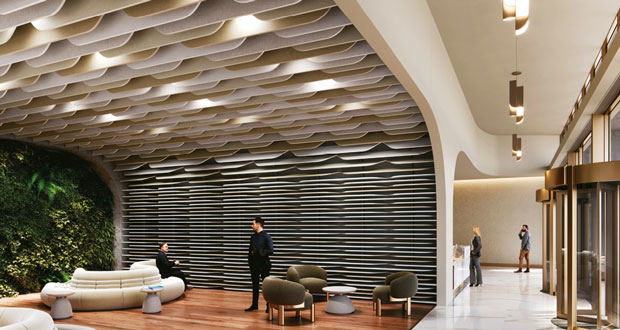SOUND MASKING
It’s clear that more than ever, communication and collaboration are essential in office environments. However, excessive noise can impede these activities. Facility managers must consider the acoustic requirements of various spaces, such as meeting rooms or collaborative areas, and ensure that they are appropriately designed to facilitate clear and intelligible communication. Implementing acoustic treatments, such as sound masking systems or strategic placement of absorptive materials, can enhance communication and collaboration among employees.
A recent edition of research body the Leesman Review points to the workplace environment being crucial in fostering connection and coaching, however employees are finding that they have more control of noise when working from home, due to the ability to take impromptu calls without disturbing others to focus at any time without being disrupted. Acoustics, it concludes is our biggest concern when in the workplace.
Marissa Wallder, Associate Director with Resonate Interiors, which works across the workplace sector including CAT A, CAT A+ and CAT B schemes as well as education and residential advises: “It should be noted that not everyone has a dedicated space to work from home and even if they do or have designed their day to intentionally collaborate in the workplace, there will be pockets of time when focus or calls within the workplace are required.
“The return to the workplace has therefore signalled an increased requirement for better acoustics to compete with the tailored home environment.” She pinpoints three key broad ‘A/B/C areas. A is for Absorption. She says: “The quality of sound has a major impact on focus & concentration. We are finding that all projects now require sound absorbing acoustic wall & ceiling treatments to be designed into the initial concept, rather than as a retrofit on day two.
“The wide variety of decorative finishes available can also have a major impact on the overall scheme, which is why it is becoming crucial to design them into the initial concept.” B refers to Blocking. “Like water, sound can pass through the tiniest gaps and so the construction of the partition and the coordination of services passing through it is critical in ensuring a space is acoustically sealed.
“An increased number of our projects now require partitions to be constructed from floor to ceiling slab, to reduce the number of weak points incurred by acoustic void barriers and the services that need to pass through them. Special attention is also required when abutting to external facades & base building elements.” C, meanwhile, is for Cover. “The electrical generation of a noise frequency to mask distracting sounds was previously a ‘nice to have’ item in a project budget, however we have seen an increased requirement of these devices within the M&E scope of works on several projects.”
EXCESSIVE NOISE
 There are a handful of other issues to address when it comes to acoustics. Excessive noise can be a major distraction and significantly hinder employee productivity. Facility managers should consider strategies to minimise reverberation and echo as these can reduce the intelligibility and further increase background noise levels. Well-designed sound absorbing materials such as acoustic ceiling tiles or wall panels can really come into their own here to control sound reflections and create a more acoustically balanced working environment which in turn enables employees to work more efficiently.
There are a handful of other issues to address when it comes to acoustics. Excessive noise can be a major distraction and significantly hinder employee productivity. Facility managers should consider strategies to minimise reverberation and echo as these can reduce the intelligibility and further increase background noise levels. Well-designed sound absorbing materials such as acoustic ceiling tiles or wall panels can really come into their own here to control sound reflections and create a more acoustically balanced working environment which in turn enables employees to work more efficiently.
While there is detailed provision for fire protection in terms of sprinklers, fire alarms and extinguishers enshrined in law, facility managers should check the requirements for office buildings in terms of soundproofing as part of building regulation compliance. In terms of health and wellbeing factors, prolonged noise levels can lead to several conditions among them stress, fatigue and even physical health issues. Controlling noise pollution is so vital to eliminate the risk of ailments such as headaches, anxiety or even hearing loss and create a healthier and more comfortable workplace.
Acoustics play a crucial role in office interiors and facility managers should prioritise its management. By focussing on factors such as speech privacy, collaboration and health and wellbeing, they can design a great place to work which means happy employees and a thriving organisation.






